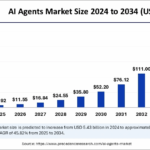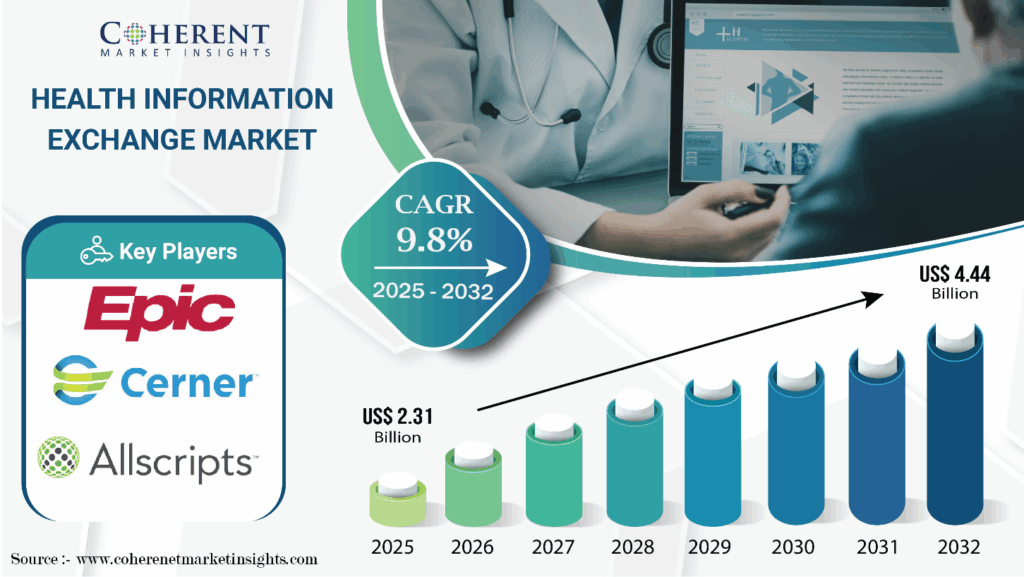Burlingame, CA, July 02, 2025 — The global health information exchange (HIE) market is on the brink of significant expansion, with its value estimated at USD 2.31 billion in 2025, projected to nearly double to USD 4.44 billion by 2032. This growth, representing a compound annual growth rate (CAGR) of 9.8%, is driven by an increasing focus on interoperability and seamless data sharing among healthcare providers, payers, and patients.
The burgeoning prevalence of chronic diseases and the pressing need for effective population health management are key factors propelling the demand for HIE solutions. As healthcare systems transition from paper-based records to electronic health records (EHRs) and electronic medical records (EMRs), the necessity for efficient and secure data exchange platforms becomes paramount.
Key Market Insights
According to the latest analysis by Coherent Market Insights, the private segment of the HIE market is expected to dominate, accounting for nearly three-fifths of the global market share in 2025. The directed exchange category is projected to hold a prominent market share of 43.2%, while the centralized model segment will likely capture 35.2% of the market.
North America is anticipated to maintain its leading position with a 37.3% share of the global market in 2025. Meanwhile, the Asia Pacific region is set to experience the fastest growth over the forecast period, driven by increasing healthcare digitalization and government initiatives.
Impact of Electronic Health Records
The widespread adoption of EHRs is a significant catalyst for the HIE market’s growth. In the United States, approximately 88.2% of office-based physicians utilize an EMR/EHR system, according to the National Center for Health Statistics. This shift towards digital healthcare systems necessitates robust HIE solutions to ensure secure and efficient data exchange.
Challenges and Opportunities
Despite the optimistic outlook, the HIE market faces challenges, notably data privacy concerns and high implementation costs. The sensitive nature of patient data means that breaches can lead to significant trust issues and compliance violations, deterring some healthcare entities from adopting HIE solutions.
Moreover, the substantial investments required for implementing and maintaining HIE systems can be prohibitive, particularly in low- and middle-income regions. However, the rise in health data volume, including medical imaging and genomics, presents lucrative opportunities for HIE vendors to develop secure and scalable solutions.
The Role of Artificial Intelligence
Artificial intelligence (AI) is revolutionizing the HIE market by transforming platforms from passive data conduits into proactive, predictive engines that enhance care coordination and workflow optimization. AI-powered analytics and predictive models are being integrated into HIE platforms, automating data entry and providing real-time clinical decision support.
“The global health information exchange market is poised to exhibit strong growth, owing to widespread adoption of HER and EMR systems, rising emphasis on value-based care models, and increasing demand for seamless interoperability across healthcare settings,” said senior analyst Manisha Vibhute.
Emerging Trends and Future Outlook
The increasing popularity of cloud-based HIE systems is a key trend shaping the market. These solutions offer scalability and remote access, making them attractive to end users. As healthcare systems often operate in silos, the demand for interoperability is expected to boost the market value of HIE.
Advanced technologies like AI are further enhancing HIE systems, enabling intelligent data analytics and predictive care. Companies like InterSystems Corporation are at the forefront of this technological integration, as evidenced by their recent launch of IntelliCare, an AI-powered EHR system designed to revolutionize healthcare engagement.
Key Developments and Market Segmentation
Recent developments in the HIE market include MEDITECH’s launch of Traverse Exchange, a nationwide health information exchange network, and Oracle’s introduction of Oracle Health Clinical Data Exchange, a cloud-based solution for streamlined medical claims processing.
The market is segmented by setup type, with private and public categories, and by type, including directed, query-based, and consumer-mediated exchanges. Implementation models are categorized into centralized, decentralized, and hybrid models, with applications spanning clinical data exchange, administrative data exchange, and public health reporting.
As the global health information exchange market continues to evolve, stakeholders are poised to benefit from the integration of cutting-edge technologies and the increasing demand for interoperable healthcare solutions.
About The Author
 US Stocks Drift as Wall Street Awaits Crucial Jobs Report
US Stocks Drift as Wall Street Awaits Crucial Jobs Report Trump Announces New US-Vietnam Trade Deal Amid Global Economic Shifts
Trump Announces New US-Vietnam Trade Deal Amid Global Economic Shifts AI Agents Market Poised for $236 Billion Growth by 2034 Driven by ML and NLP
AI Agents Market Poised for $236 Billion Growth by 2034 Driven by ML and NLP U.S. Oil Prices Drop as Crude and Gasoline Inventories Surge
U.S. Oil Prices Drop as Crude and Gasoline Inventories Surge Trailways Ranks Among Top 3 U.S. Bus Services in USA Today Awards
Trailways Ranks Among Top 3 U.S. Bus Services in USA Today Awards